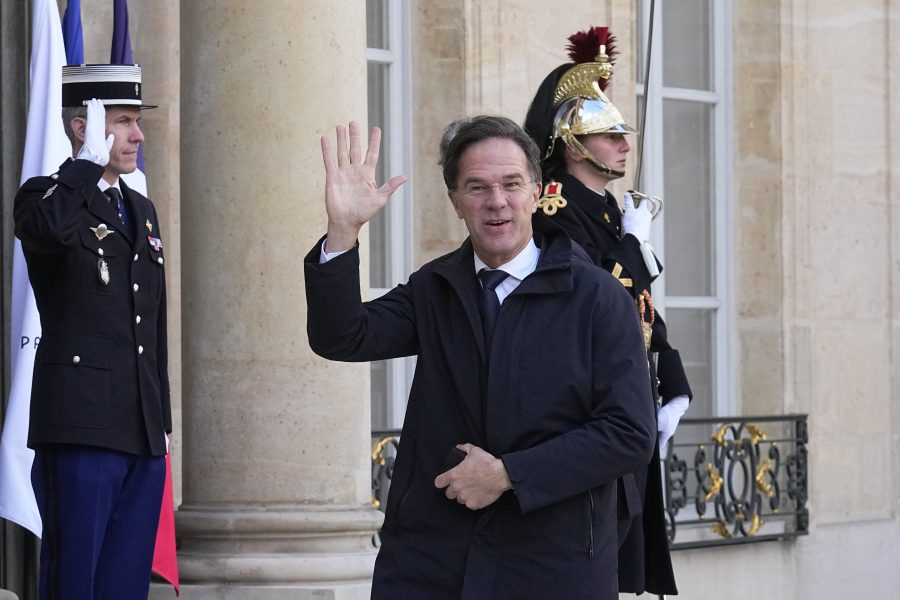Biden paves way for Mark Rutte to lead NATO — and confront Putin

President Joe Biden is supporting Dutch Prime Minister Mark Rutte to become the next NATO secretary general, a U.S. official said Wednesday.
Biden’s support is likely to sway more allies to get on board with Rutte’s nomination, after months of jockeying between him and several other European leaders for the job. The U.S. official was granted anonymity to reveal the president’s support on a matter he hasn’t backed publicly.
POLITICO reported earlier on Wednesday that two-thirds of NATO countries are backing Rutte’s nomination to take over leadership of the military alliance later this year.
The term of current NATO chief Jens Stoltenberg, who has steadily navigated the political-military bloc through a tumultuous time in transatlantic politics since 2014, ends in October.
Pressure is mounting to approve Rutte’s leadership bid before the NATO summit in July, which will be held in Washington to celebrate the alliance’s 75th anniversary.
Estonian Prime Minister Kaja Kallas expressed interest in the NATO top job during an event hosted by POLITICO in November. But NATO officials say she’s not in the mix since she has not declared her candidacy. The same goes for Latvia’s Foreign Minister Krišjānis Kariņš, who did a mini media tour last year to test the waters.
Rutte’s path to the secretary general role puts him on a collision course with Russia, as the alliance steels itself against Vladimir Putin’s aggression two years since the full-scale Ukraine invasion. And should former President Donald Trump get back to the Oval Office, the Dutch leader would have to navigate the Republican’s skepticism of NATO and collective security.
Rutte wouldn’t discuss his bid to lead the alliance at this past weekend’s Munich Security Conference gathering world leaders, saying he’d learned his lesson back in October when he suggested he was interested in the job.
“I made the mistake in October talking about, ‘I might be interested in that role’ and then that mushrooms,” he said during a small media scrum. “I shouldn’t have done that, so I decided not to talk about that anymore.”
Rutte has a ways to go before any decision is made. Under NATO rules, the secretary general has to be decided by unanimous consent, meaning that Rutte still has to win the backing of all 31 member nations. Any candidate for the job must get through Turkey and Hungary, which have proven the biggest hurdles to accepting new members. Turkey has reportedly asked for reassurances before backing Rutte, while Hungary has had longstanding disagreements with the Dutch premier.
Speaking with Dutch television over the weekend, Dutch Chief of Defense Gen. Onno Eichelsheim said it was “very likely” that Rutte would get the top job.
Defense spending remains a major concern of the alliance, with countries struggling to hit the decade-old 2 percent of GDP defense spending target that the alliance established in the wake of Russia’s initial invasion of Ukraine in 2014.
This year, 18 of the 31 NATO countries are set to finally meet the 2 percent standard, compared with only seven last year. The Netherlands has yet to reach that mark, but is on track to spend 2 percent this year.
As much as he dodged questions about potentially leading the transatlantic alliance at Munich, Rutte still sounded every bit the presumptive NATO leader. He told reporters in the same scrum that the threat of Russia attacking a NATO country is real, but “the best way to prevent it is to make sure that we have done everything to invest in our defense, making sure that the alliance stays strong.”
Part of that means keeping Washington in the fold, something that outgoing NATO chief Stoltenberg invested plenty of time and energy into ensuring during the Trump years.
With Stoltenberg — who has already had his term extended twice — leaving in October just weeks before the next U.S. presidential election, his successor might face a similar task.
Whoever occupies the White House, NATO will have to contend with what many expect to still be a shooting war in Ukraine, and a push by many Republicans in Washington to leave Kyiv’s war to Europe, refocusing American attention on China in the Indo-Pacific.
One of the big concerns of the alliance in 2024 and beyond is how to work with individual nations that are restocking their warehouses after two years of funneling weapons and equipment to Ukraine, and had previously spent relatively little on defense after the collapse of the Soviet Union.
The alliance has big decisions to make in long-term investments for new, often expensive, precision-guided munitions. It also must strike a balance between calls in Washington to buy American and Europe’s own ambitions to build up the continent’s defense manufacturing capabilities.
Under Rutte, the long-serving Dutch prime minister and one of Europe’s longest-serving leaders, the Netherlands has already committed to send Ukraine 24 of its F-16 fighters — the most of any country — and is helping train Ukrainian pilots. The Dutch military has also sent tanks, artillery systems, ammunition and Patriot air defense systems to Kyiv over the past two years. The government has pledged another $2.1 billion in military and humanitarian aid for Ukraine over the coming year.
Rutte said in Munich that the need for Europe to invest more in its own defense has more to do with Russia than it does who sits in the White House.
“Let’s stop moaning and nagging and whining about Trump,” he said. “We need to invest in our defense expenditure. We need to massively ramp up arms production and then we need to massively do more in support to Ukraine.”
Go To Source
Author: POLITICO

